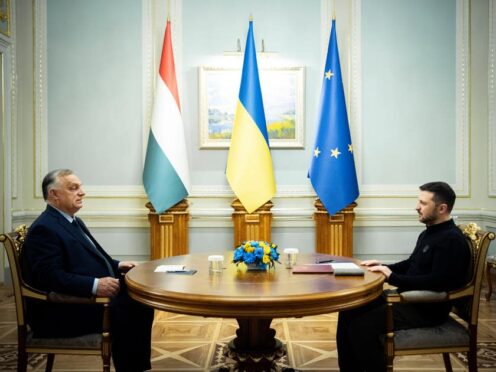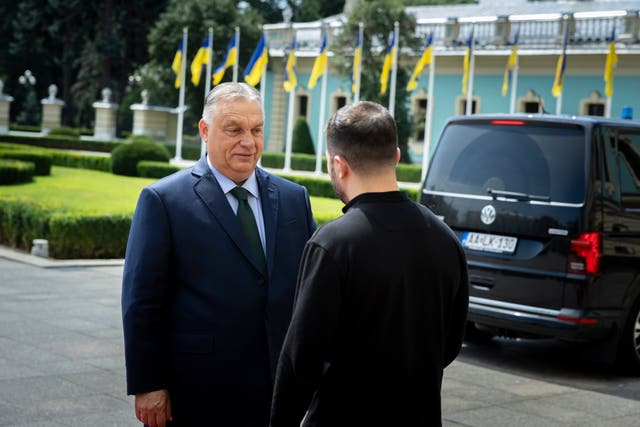
Hungarian Prime Minister Viktor Orban was in Kyiv on Tuesday for talks with Ukrainian President Volodymyr Zelensky – his first visit to the country since Russia’s full-scale invasion in February 2022.
Mr Orban’s press chief confirmed to Hungarian news agency MTI that the prime minister had arrived in the Ukrainian capital in the morning for the talks.
Bertalan Havasi said the main topic of the meeting will be the opportunity for building peace as Ukraine fights off Russia’s invasion.

Officials in Kyiv did not confirm Mr Orban’s arrival.
His visit was a rare gesture in a relationship that long been marred by tensions.
Known as Russian President Vladimir Putin’s closest EU ally, Mr Orban has routinely blocked, delayed or watered down EU efforts to extend assistance to Ukraine and to sanction Moscow over its war, frustrating both Mr Zelensky other EU leaders.
He has also accused Kyiv of mistreating an ethnic Hungarian minority in Ukraine’s western region of Zakarpattia, a community he has used to justify his refusal to provide weapons to Ukraine or allow their transfer across the two countries’ shared border.
The self-described “illiberal” leader has long been accused by his European partners of dismantling democratic institutions at home and acting as an obstinate spoiler of key EU policy priorities.
The bloc has frozen more than 20 billion dollars (£1.8 billion) in funding to Budapest over alleged rule-of-law and corruption violations, and Mr Orban has conducted numerous anti-EU campaigns depicting it as an overcentralised, repressive organisation.

The visit comes the day after Hungary took over the six-month rotating presidency of the European Union, a position that has little real power but can be used to set the tone of the bloc’s agenda.
Hungarian officials have indicated that they will act as “honest brokers” in the role despite worries from some EU legislators that Hungary’s democratic track record makes it unfit to lead the bloc.
Kremlin spokesman Dmitry Peskov played down the importance of the visit, saying Hungary “must fulfill (the) functions” of its EU presidency and adding that Moscow had no particular expectations for its outcome.
Mr Orban’s visit also comes as he seeks to recruit members into a new nationalist alliance that he hopes will soon become the largest right-wing group in the European Parliament.
On Sunday, he met in Vienna with the leaders of Austria’s far-right Freedom Party and the main Czech opposition party, announcing the formation of the new group, “Patriots for Europe”.
The trio would need to attract legislators from at least four more EU countries to successfully form a group in Europe’s new parliament, which held elections in June.
Right-wing nationalist parties across Europe strengthened their position in the elections, but ideological differences over the war in Ukraine and cooperation with Russia have often prevented deeper alliances among some of the parties.

Enjoy the convenience of having The Sunday Post delivered as a digital ePaper straight to your smartphone, tablet or computer.
Subscribe for only £5.49 a month and enjoy all the benefits of the printed paper as a digital replica.
Subscribe